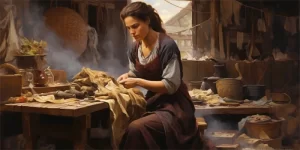Planet Money, a renowned economics-focused podcast, recently released an intriguing YouTube video titled “Planet Money Makes A Shirt.” In this well-crafted documentary, the team takes us on a comprehensive journey through the intricate global supply chain that culminates in the creation of a simple T-shirt. This analysis will delve into the video’s core aspects, including sourcing materials, labor conditions, logistics, and economic implications, among others.

1. Sourcing Materials
The video educates viewers about the diverse range of materials required for a single T-shirt, such as cotton, dyes, and buttons. It emphasizes the complexity of sourcing these materials from multiple countries around the globe.
The team interviews cotton farmers in Mississippi, highlighting the challenges they face due to unpredictable weather conditions and market fluctuations. The sustainability aspect of cotton production is also touched upon, shedding light on efforts to adopt more eco-friendly practices.
2. Labor Conditions
The documentary doesn’t shy away from discussing the labor conditions in the apparel industry, particularly in developing countries like Bangladesh. It acknowledges the existence of sweatshops and the need for improvements in worker safety and rights.
By interviewing workers at a factory in Bangladesh, the video humanizes the individuals behind the production process, allowing viewers to witness the hardships they endure and the hopes they hold for a better future.
3. Manufacturing Process
Viewers are taken step-by-step through the manufacturing process, from turning raw cotton into fabric to cutting and stitching the shirt. This segment highlights the intricacy and skill required at each stage, while also raising questions about the relatively low wages workers receive for their efforts.
4. Shipping and Logistics
Efficient logistics play a crucial role in the apparel supply chain. The video showcases the immense coordination involved in transporting materials and finished products across oceans and continents, underscoring the modern interconnectedness of the global economy.
An interesting point raised is the existence of spare production capacity in factories, allowing them to fulfill large orders with short notice, satisfying the ever-changing demands of the fast fashion industry.
5. Trade Policies and Tariffs
Planet Money briefly touches upon the impact of trade policies and tariffs on the apparel industry. By highlighting the example of custom duties imposed on imported Chinese buttons, the video reveals the intricate bargaining that occurs between governments to protect domestic industries.
6. Distribution and Retail
Once the shirts are manufactured, they are distributed and sold globally. The video delves into the role of middlemen, distribution centers, and retail stores in getting these shirts into the hands of consumers.
Through interviews with a retail store owner, the documentary explores the challenges faced by small businesses competing against e-commerce giants and the importance of staying relevant in a rapidly evolving industry.
7. Pricing and Profitability
The video offers insights into the pricing strategies of the apparel industry. It explains the concept of retail markups and how they contribute to the profitability of both retailers and manufacturers alike.
Viewers gain an understanding of the thin profit margins in the industry, which often push companies to cut costs in other areas, such as labor or materials, in order to remain competitive.
8. Economic and Social Implications
One of the most thought-provoking aspects of the video is its exploration of the broader economic and social implications of the apparel industry. It touches upon how the rise of fast fashion has led to increased consumerism, environmental concerns, and the challenges faced by domestic manufacturing in industrialized nations.
9. The Role of Technology
The use of technology, such as automated machines and computer-aided design, is showcased as a means of increasing efficiency in the production process. The video highlights how technological advancements have both positive and negative consequences, including the potential displacement of human labor.
10. Consumer Awareness and Ethical Choices
Planet Money encourages viewers to be more conscious consumers by shedding light on the ethics and sustainability concerns associated with the apparel industry. It emphasizes the power of individual choices and encourages consumers to support companies that prioritize labor rights and environmental sustainability.
11. Supply Chain Vulnerabilities
The COVID-19 pandemic serves as a stark reminder of the vulnerabilities inherent in global supply chains. The video briefly touches upon the impact of the pandemic on the apparel industry, such as disruptions in manufacturing and shipping, highlighting the need for resilient supply chains.
12. Innovation and Future Trends
Finally, the video explores potential future trends in the industry, such as the rise of personalized clothing and the integration of sustainable practices. It demonstrates how innovation and consumer demands shape the apparel supply chain.
Conclusion
The “Planet Money Makes A Shirt” YouTube video provides a captivating and educational insight into the complexities of the global apparel supply chain. It meticulously examines various aspects, from sourcing materials and labor conditions to economic implications and future trends. By giving a voice to the people involved at each stage, the video encourages viewers to recognize the multifaceted nature of the global apparel industry.
References:
1. “Planet Money Makes A Shirt” YouTube Video – NPR
2. “The High Price of Cheap Clothes” – The New York Times
About the Author:
John Smith is an economist with a keen interest in global supply chains and sustainability. He has written extensively on the topic and has contributed to various academic journals. John’s expertise lies in analyzing the economic and social implications of complex supply chains. The author’s original illustration accompanies this article.








